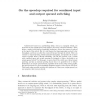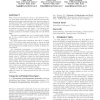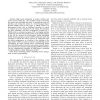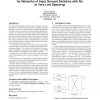40 search results - page 2 / 8 » Input Queued Switches: Cell Switching vs. Packet Switching |
AUTOMATICA
1999
13 years 4 months ago
1999
Architectures based on a non-blocking fabric, such as a crosspoint switch, are attractive for use in high-speed LAN switches, IP routers, and ATM switches. These fabrics, coupled ...
SPAA
2006
ACM
13 years 10 months ago
2006
ACM
Most common network protocols (e.g., the Internet Protocol) work with variable size packets, whereas contemporary switches still operate with fixed size cells, which are easier t...
ICC
2007
IEEE
13 years 11 months ago
2007
IEEE
A multi-cabinet implementation of a combined input and crosspoint queued (CICQ) switch introduces a large RTT latency between the line cards and switch fabric, requiring a large cr...
ICC
2007
IEEE
13 years 11 months ago
2007
IEEE
— High power dissipation in packet switches and routers is fast turning into a key problem, owing to increasing line speeds and decreasing chip sizes. To address this issue, we i...
CCR
2006
13 years 4 months ago
2006
The delay and throughput characteristics of a packet switch depend mainly on the queueing scheme and the scheduling algorithm deployed at the switch. Early research on scheduling ...




